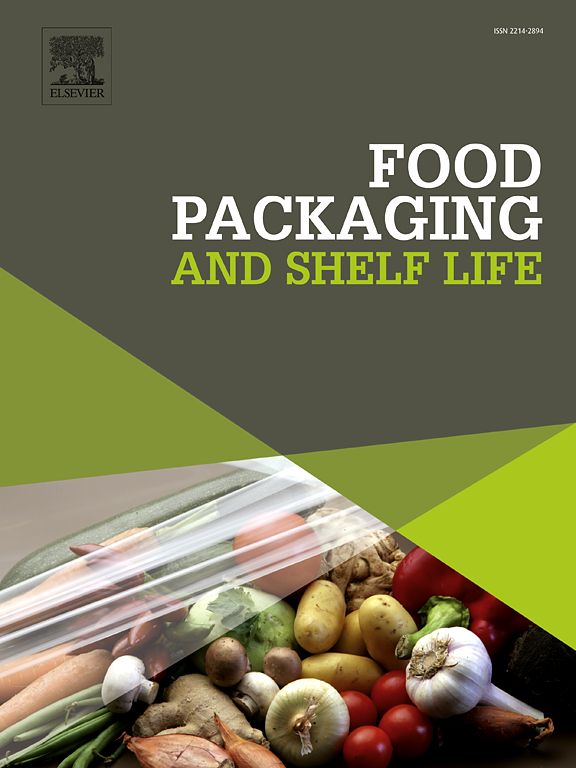纤维素纳米晶和甲基丙烯酸缩水甘油酯增强新型菜籽粕纳米复合包装膜的性能
IF 10.6
1区 农林科学
Q1 FOOD SCIENCE & TECHNOLOGY
引用次数: 0
摘要
为了减轻油菜籽粕过度使用对环境的污染,提高油菜粕的利用率,采用甲基丙烯酸缩水甘油酯(GMA)和纤维素纳米晶体(cnc)对油菜粕进行改性,制备了一种新型的纳米复合膜。cnc以其高表面积、比强度、低密度和形成氢键的能力而闻名,在各种材料中用作有效的补强剂。同时含有甲基丙烯酸和环氧基团的GMA修饰了菜籽分离蛋白,得到了不同接枝度的偶联物。采用湿法铸造和热压缩相结合的方法制备了纳米复合膜,并对其进行了综合表征。结果表明,GMA的加入提高了薄膜断口的致密性。同时加入cnc和GMA时,CM纳米复合膜的热稳定性显著提高,拉伸强度在0.5GMA-5CNC时达到最大值。实验结果还表明,GMA和cnc与蛋白质形成共价键,并与CM基质中的纤维反应,在纳米复合材料中形成新的有序结构。0GMA-5CNC膜具有较强的DPPH自由基清除活性,而0.5GMA-5CNC膜的蓝莓减重最小。此外,CM复合膜在堆肥条件下表现出良好的分解性能。总的来说,这项研究突出了CM纳米复合膜作为传统石油基产品的可持续替代品的潜力。本文章由计算机程序翻译,如有差异,请以英文原文为准。
Enhanced properties of novel canola meal nanocomposite packaging films reinforced with cellulose nanocrystals and glycidyl methacrylate
To mitigate environmental pollution caused by the excessive use of petroleum-based products and enhance the utilization of canola meal (CM), a novel nanocomposite film was developed by modifying CM with Glycidyl methacrylate (GMA) and Cellulose nanocrystals (CNCs). CNCs, known for their high surface area, specific strength, low density and the ability to form hydrogen bonds, serve as effective reinforcing agents in various materials. GMA containing both methacrylic and epoxy groups, modifies rapeseed protein isolate, yielding conjugates with different grafting degrees. The nanocomposite film was fabricated using a combination of wet casting and heat compression, followed by comprehensive characterization.
Results
showed that incorporating GMA improved the compactness of the film’s fracture surface. Thermal stability of CM nanocomposite films significantly increased when both CNCs and GMA were incorporated, with maximum tensile strength obtained at 0.5GMA-5CNC. Experimental results also indicated that GMA and CNCs formed covalent bonds with proteins and reacted with fibers in the CM matrix, creating new ordered structure within the nanocomposites. The 0GMA-5CNC film exhibited strong DPPH radical scavenging activity, while blueberries wrapped in 0.5GMA-5CNC experienced minimum weight loss. In addition, the CM composite film demonstrated excellent disintegration under composting conditions. Overall, this study highlights the potential of CM nanocomposite film as a sustainable alternative to traditional petroleum-based products.
求助全文
通过发布文献求助,成功后即可免费获取论文全文。
去求助
来源期刊

Food Packaging and Shelf Life
Agricultural and Biological Sciences-Food Science
CiteScore
14.00
自引率
8.80%
发文量
214
审稿时长
70 days
期刊介绍:
Food packaging is crucial for preserving food integrity throughout the distribution chain. It safeguards against contamination by physical, chemical, and biological agents, ensuring the safety and quality of processed foods. The evolution of novel food packaging, including modified atmosphere and active packaging, has extended shelf life, enhancing convenience for consumers. Shelf life, the duration a perishable item remains suitable for sale, use, or consumption, is intricately linked with food packaging, emphasizing its role in maintaining product quality and safety.
 求助内容:
求助内容: 应助结果提醒方式:
应助结果提醒方式:


